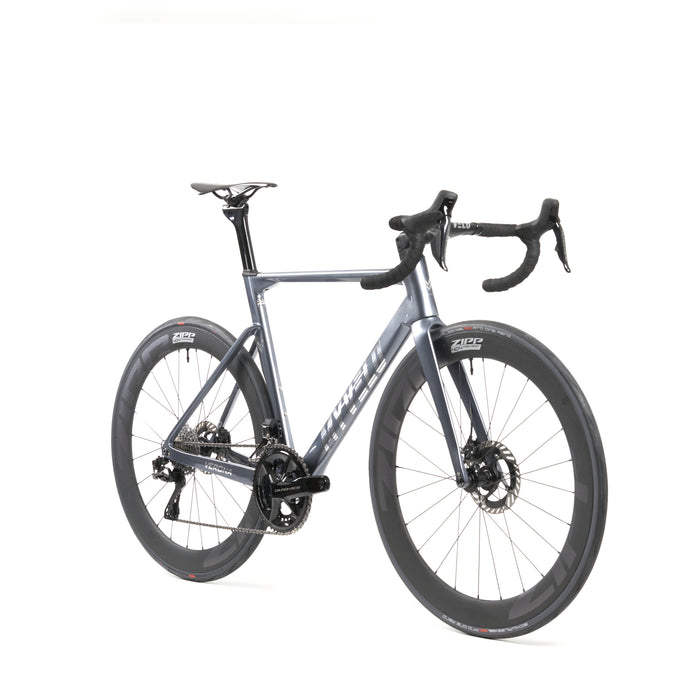
Verona road bike
incl. FREE shipping & free returns

Biomechanics play a crucial role in cycling, especially when it comes to riding position and pedaling technique. Recent scientific studies have shown that these factors have a significant impact on cyclists' performance, efficiency, and injury risk.
Von Björn Kafka |
3 minutes read time

In this article, we look at the latest findings on optimal riding position, correct pedaling technique, and practical recommendations for improved power transmission.

Correct sitting position directly influences muscle activation, energy expenditure, and aerodynamic efficiency. An incorrect sitting position can not only impair performance but also increase the risk of overuse injuries.
Optimal saddle height is one of the most important factors for efficient power transmission. A study by Vrints et al. (2011) investigated the effects of different saddle positions on maximum power output and torque generation capacity of the lower extremities. The results showed that a saddle position that is too low reduces maximum power output by altering the kinematics of the knee joint and impairing the mechanical performance of key muscle groups such as the biceps femoris, rectus femoris, and vastus intermedius.
A systematic review by Holliday and Swart (2021) analyzed various studies on optimizing cycling position. The authors found that changes in trunk tilt, saddle height, and handlebar height can have significant effects on performance. In particular, trunk tilt influences aerodynamic efficiency and energy consumption.
A low handlebar promotes an aerodynamic posture, but can also place greater strain on the neck, shoulder, and wrist muscles. An ergonomic compromise between aerodynamics and comfort is particularly crucial for long-distance riders. Studies have shown that a moderately flexed torso position facilitates breathing and allows for improved oxygen uptake, which in turn supports endurance performance.
Correct sitting position significantly influences the efficiency of the pedaling motion. A poorly adjusted position can lead to uneven muscle loading and promote inefficient movements. Research has shown that optimal knee extension during the pedaling cycle is approximately 25-30 degrees. A sitting position that is too high or too low can result in suboptimal force angles, leading to energy loss.

In addition to riding position, pedaling technique is a crucial factor for cycling performance. Efficient pedaling technique enables consistent power transmission throughout the entire pedaling cycle and minimizes energy loss.
The pedal stroke can be divided into four phases:
Press phase (0°-180°): In this phase, the primary force is exerted downward. The quadriceps and gluteus maximus play a crucial role here.
Transition phase (180°-270°): Here the pressure on the pedal decreases while the opposite side enters the pull phase.
Pull phase (270°-360°): The hamstrings and calf muscles pull the pedal upwards to support a rounded pedal stroke.
Transition phase (360°): The cycle starts again.
A circular pedaling motion is particularly efficient because it reduces the strain on individual muscle groups and uses the entire muscle chain.
The optimal cadence is usually between 80 and 100 rpm, although professional riders often ride above 100 rpm. A cadence that is too low increases muscular strain and leads to fatigue more quickly, while a cadence that is too high can increase energy consumption. Studies have shown that consciously optimizing cadence leads to improved aerobic performance.
The position of the cleats influences power transfer to the pedal. A position too far forward or too far back can negatively impact the biomechanics of pedaling. Studies recommend a cleat position just behind the ball of the foot to ensure optimal power transfer while minimizing the risk of knee problems.

Based on the studies mentioned, cyclists should individually adjust their riding position to ensure optimal knee kinematics and muscle activation:
Adjust the saddle height correctly: The knee flexion should be between 25-30 degrees at the bottom dead center of the pedal stroke.
Adjust the handlebar height individually: A low handlebar increases aerodynamics but can impair comfort.
Carefully adjust the cleat position: The cleats should be positioned just behind the ball of the foot to allow for efficient power transfer.
Train your cadence: A higher cadence reduces muscular fatigue and improves endurance.
Optimize pedaling technique: One-legged pedaling and the use of power meters help to develop a smooth pedaling motion.
Pedaling technique should be practiced regularly to promote consistent power transfer. This can be supported by targeted exercises such as single-leg pedaling or the use of power meters to obtain better feedback on pedaling technique.
Biomechanics, especially riding position and pedaling technique, have a significant impact on cycling performance. Optimally adapting these factors can not only increase efficiency but also minimize the risk of injury. Modern biomechanical analyses and performance measurements provide a valuable basis for finding the ideal riding position and optimizing power transfer. Whether you're an amateur or professional cyclist, those who focus on their own biomechanics can benefit from better long-term results.